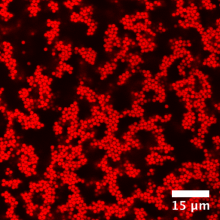
Wet Systems:
Particle-liquid mixtures are ubiquitous in particle science and engineering. Examples include materials such as cement, paints, inks, paper coatings, coal slurries, ceramic green bodies, and some pharmaceuticals and foods, to name a few. The properties range from liquid-like suspensions (e.g. ink) to elastic-like gels and glasses (e.g. ceramic green bodies), highly viscoelastic filled polymers (e.g. polymer nanocomposite automotive parts), and history-dependent thixotropic pastes (e.g. toothpaste). Indeed, wet systems often fall into the realms of soft matter, colloid and interface science, and suspensions. Wet systems also occur during many particle formation and processing steps, including particle dispersion, spray drying, wet milling, crystallization, and filtration.
Key, recent focus areas in wet systems include suspension rheology, wet milling including nanoparticle formation, colloidal gels, particle dispersion, and drying. Two common themes run throughout the work: structure-property relationships and the connection between particle properties and particle interactions and bulk properties. IFPRI funded research includes the development of theory, simulation tools, new experimental methods, and the integration of theory, experiment, and simulation to develop an advanced understanding of how to manipulate particle interactions to achieve a desired bulk behavior or processing outcome.
Some relevant examples of very recent IFPRI funded research are shown in the illustration below, adapted from FRR 57-06, “Microstructure in gelling Systems” by Eric Furst (U. Delaware) and Michael Solomon (U. Michigan). This IFPRI funded research combined the strengths of two leading academic research groups to explore structure property relationships in colloidal depletion gels and led to new model systems, the development of advanced characterization methods and a quantitative testing of the link between colloidal interactions and gel properties. This work continues with a study of long-term gel stability by Wilson Poon (U. Edinburgh)
IFPRI supported wet systems research on Suspension Rheology from 1980-2003 (IFPRI member access only) has been summarized by Howard Barnes. IFPRI guidance and support plays a prominent role in the recent monograph, “Colloidal Suspension Rheology” by J. Mewis and N. Wagner (Cambridge Univesity Press, ISBN: 9781107622807), both IFPRI grantees and consultants. Mewis & Wagner also published a recent review on Thixotropy that is publically available (Adv. Coll. Int. Sci. 2009 ;147-148:214-27doi: 10.1016/j.cis.2008.09.005). A recent IFPRI sponsored review of suspension rheology by Denn & Morris has appeared and is publically available online: “The Rheology of Suspensions” Annu. Rev. Chem. Biomol. Eng. 2014. 5:203–28 DOI: 10.1146/annurev-chembioeng-060713-040221
Past sponsored research projects in Wet Systems comprise 121 IFPRI reports: Wet Systems Publications
